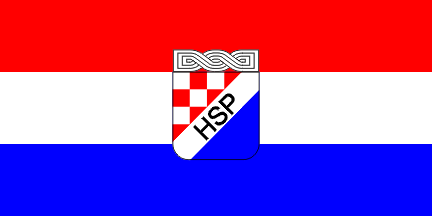
by Željko Heimer, 7 May 2005

Last modified: 2005-05-28 by dov gutterman
Keywords: croatian party of rights | hrvatska stranka prava | hsp |
Links: FOTW homepage |
search |
disclaimer and copyright |
write us |
mirrors
See also:
HSP (Hrvatska Stranka Prava, the Croatian Party of Rights) is a right wing party (right here and 'rights' in the name have no connection, though) follower of the party of the same name founded in 19th century being the oldest Croatian political party (established 1861). It was renewed around 1990, both in Croatia and Bosnia and Herzegovina (also there were several parties, or fractions, which claimed the name and herittage). Soon after the begining of the war in Croatia, and later in Bosnia and Herzegovina, organized military units to fight as protection against aggression. The HSP army was called HOS - Hrvatske Obrambene Snage, Croatian Defence Forces).
The HSP uses the Croatian tricolour with the party emblem in
the middle - shield divided per bend, chequy and blue with white
bend bearing the initials of the party, and above the shield a
tripple-wattle ornament. Several fractions and other parties
claiming the same name (or similar one, adding differenciating
attribute) use similar flags with minor differences.
Željko Heimer, 16 March 1998
The flag is Croatian tricolour with party emblem in the middle
- emblem consisting of a shield divided by a white bend sinister
with yellow letter HSP, the upper field being chequy red and
white and lower field is blue. The shield is topped with triple
wattle ornament. The flag is used in variations since 1861,
abandoned after the virtual disolving of the party in 1941. The
party was reestablished in 1990 and readopted the flag. In year
2000 the party changed the visual identity, but if the flag was
changed too it is not known.
Željko Heimer
Established: Zagreb, 25 Febuary 1990. Members: 1996 (30.000),
1997 (30.000), 1998 (30.000), 1999 (30.000), 2002 (25.000).
Members in Croatian Parliament: 1992-1995 - 3 (2,17%), 1995-1999
- 3 (2,34%), 2000 - 4 (2,65%), 2003 - 4 (2,65%) , 2004 - 7
(4,61%). While this right winged party drasticaly changed its
symbolic of lately showing itself as an European neo-conservative
party, in the 1990 was fliring with Ustasha
symbolic and ideology. The flag is described in the Statutes
(Statut HSP, 28 February .2004 <www.hsp.hr>).
The flag is Croatian tricolour with party emblem in the middle -
emblem consisting of a shield divided by a white bend sinister
with balck letters HSP, the upper field being chequy red and
white and lower field is blue. The shield is topped with triple
wattle ornament. In the long history of this party (1841!) the
emblem was sligtly changed occasionally, using golden initials
and wattle and other smaller differences. The flag of HSP is to
be seen hoisted on their headquarters in Zagreb and in some other
of their offices around the city.
Željko Heimer, 7 May 2005
Hrvatske Obrambene Snage, Croatian Defence Forces - The flag
was used with some variations, most notably with larger symbol
and without the circular wreath. HOS was military organization of
Croatian Party of Rights (HSP), whose flag was also used
(tricolour with shield tierced per bend sinistre chequy
red-white, white with golden initials HSP and blue). The
(para)military organization was active both in Croatian and
B&H at the begining of the war, but latter was disbanded,
some of the units included in the regular army.
Željko Heimer
The HOS used a black flag with the emblem in the middle, with
a circle of tripple-wattle within which is a chequy shield (with
white first square) over a four-sided blue-white triple wattle
(similar to the one used as Ustasha symbol, on flags of the
Independent State of Croatia in World War II), above the
inscription HOS, below HSP, ZA DOM SPREMNI (motto also used in
World War II Croatian state).
Željko Heimer, 2 March 1999